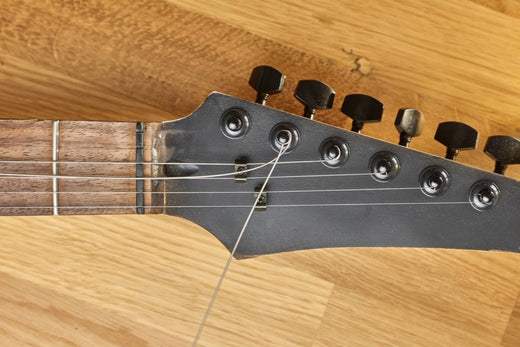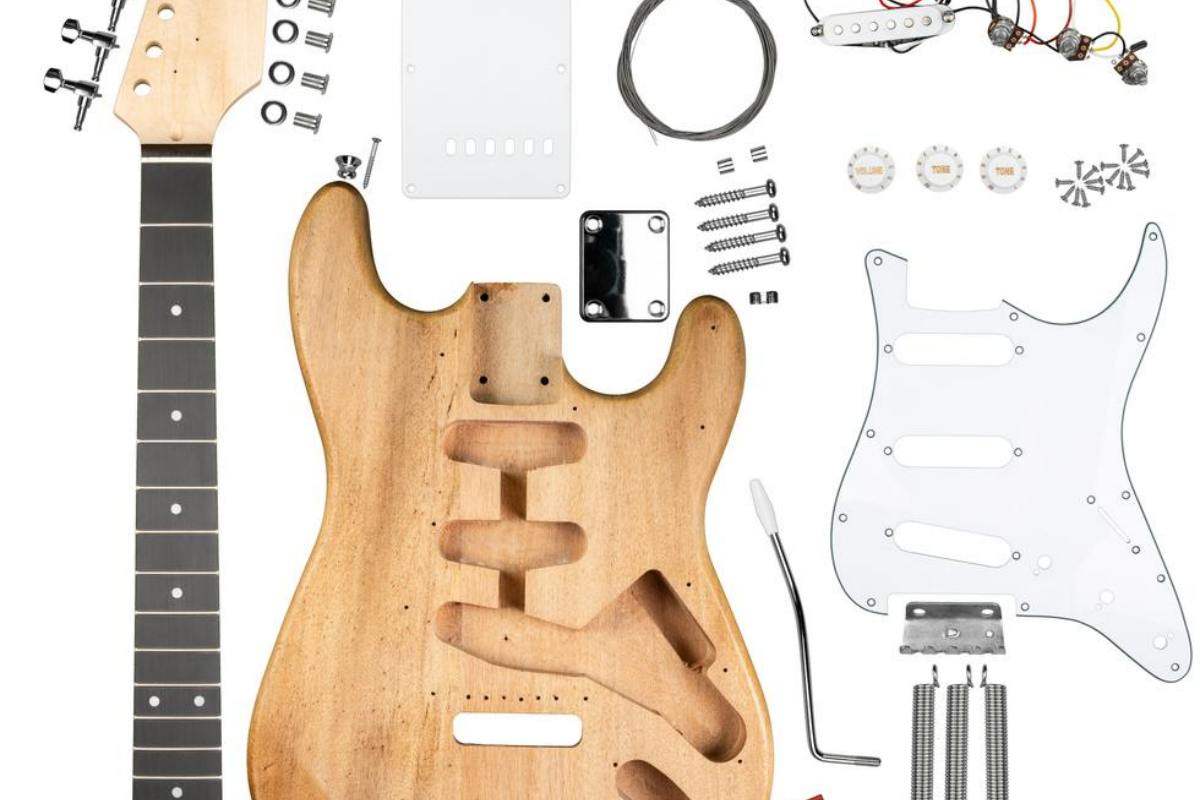If you hear new-age guitarists talk about tuners, they probably mean guitar-tuning devices and apps. However, this term used to have a different meaning. A properly tuned guitar will sound at its finest, and the prerequisite for that is having a set of properly functioning machine pegs and that is also called guitar tuners.
There is more to guitar tuners, than just cranking the gears. What if a peg comes loose, or if it gets too worn over time, and your tuning is becoming more and more inconsistent?
Is it possible to effectively use guitar tuning machines even if you don’t know anything about them? Absolutely.
However, learning how guitar tuners work, how to install & replace them, and how to properly apply guitar tuning machine maintenance, etc. may prove to be invaluable knowledge in the long run; we’re here to break down everything there is to know about them, so let’s start from the top.
- What Are Guitar Tuning Machines?
- Components of a Tuning Machine
- Why Do You Need To Upgrade Your Guitar Tuners?
- Different Types of Guitar Tuning Machines & How They Work
- How to Choose Tuners - Things to Consider
- How to Install Tuning Pegs
- FAQs about Guitar Tuning Pegs

What Are Guitar Tuning Machines?
Tuning machines, machine heads, gears, pegs, tuning buttons, tuning keys or simply tuners are mechanical devices designed to help guitar players tune their guitars. This is done by tightening or loosening the pegs, which increase or decrease the string tension, respectively.
Both electric and acoustic guitars typically feature six of them - one for each string. If your guitar has more than 6 strings, it will need additional tuning pegs until the numbers match. As you can guess, each tuning machine governs the tension of a single string, and this is universal across all types of guitar tuning machines.
Tuners are typically located on the guitar’s head. The so-called “headless” guitars are equipped with a unique type of tuning machines that are located below the bridge but serve the same purpose as conventional pegs. You can read the article to check how headless guitars work.
Components of a Tuning Machine
- Tuning peg/button/keys: Where you hold the tuners to adjust the string tension.
- Worm gear: Has different ratios so that you turn different numbers of rounds to adjust the strings.
- Bushings & washers: You used to secure the peg to the guitar head.
- Screws: You used to screw your peg to the guitar head.
- String post: Insert to the guitar head to make sure your string can go through and get secured.
Why Do You Need To Upgrade Your Guitar Tuners?
Tuning Instability
Factors like old strings, nut slots, and bridges can also cause your tuning to waver. But if you have fixed the other factors and the tuning problem is still there, you can consider whether it is your tuners' problem.
Wear and Tear
Machine wears out as times goes by, tuning machines are the same. If your current guitar tuners have been around for so long and they finally got wear and tear, it's time to replace them with new ones.
Difficulty in Tuning
Haven't carried out proper and regular maintenance? Your tuners might become stiff or hard-to-turn tuning pegs and need to be replacd with new ones.
Noise Issues
Hear clicking or grinding sounds in the gear during tuning? Your tuning machines are broken and need to change.
Desire for Improved Performance
Just want better precision, or better look, or just one to change to another type. Get yourself some new tuners.
Different Types of Guitar Tuning Machines & How They Work
Several types of guitar tuning pegs exist, although, for simplicity’s sake, we could group them into “regular” and “locking” tuners. All other categorizations simply highlight the differences in terms of maintenance and aesthetics between different types while they’re functionally almost identical.
All tuners operate on a simple principle - turning them clockwise tightens the string while turning them counterclockwise loosens it. It’s important to note that this is only true as long as the strings are properly run through and around the tuners.
Whether you’re buying a new set of tuning pegs or simply want to learn more about how they work, I’ll explain the most popular machine head types below.

Open-back & sealed tuners
Depending on whether the tuning gear is exposed or covered, it can be described as open-back or sealed.
The first difference between the two is largely based on aesthetics - some guitarists like having the ability to watch the cranking gears as the strings are tightened/loosened, while others prefer closed-back tuners because they look more refined.
From a functional standpoint, caring for open-back tuners is easier, but they wear faster as they’re exposed to a variety of harmful factors (e.g. dirt and dust). Lubricating them is considerably simpler and can be done without removing the pegs from their posts. Sealed tuners, on the other hand, require significantly less care and tend to last longer.
Both types serve the same purpose. As you turn the peg, the worm gear moves and tightens/loosens the string. The only difference is that you won’t actually see the worm & pinion gears on a sealed tuner.
Side-mounted & inline tuners
Depending on whether there are two pairs of three tuning pegs mounted on each side of the guitar’s head or a single set of six placed horizontally along it, we have side-mounted and inline tuners.
Both types work exactly the same, but there is one small difference; inline tuners are better suited for guitars with taller headstocks, while 3x3 side-mounted tuners (or 3L+3R tuners) require a wider head. Theoretically, any set of tuning pegs could be placed on almost any guitar, but having a suitable headstock allows luthiers to find a proper angle without having to rely on string trees too much.

Regular & locking tuners
Design-wise, the invention of locking tuners changed the game for guitarists worldwide. These contraptions may look the same as regular tuning pegs on the outside, but they feature a simple locking pin that completely blocks all string movement.
On the other hand, strings run through “regular” tuning machines or non-locking tuners will always wiggle at least a bit. Whenever you play, the vibrations will make them move, but they’ll quickly resettle afterward. With lock-in tuners, this doesn’t happen at all and leads to more consistent intonation.
Press-fit & screw-on tuners
Press-fit tuners, also known as push-in tuners, are inserted into the headstock without screws, relying on precise fitting and friction to stay in place. They offer a clean, streamlined look and easier installation but might be less secure over time.
Screw-on tuners, on the other hand, are attached with screws, providing a more stable and durable connection. They are less likely to shift or loosen, ensuring consistent tuning stability.
Staggered Tuners
What are staggered tuners? Staggered tuners are tuners that are staggered - no surprise there! By that I mean, the first tuner (low E string) is taller than the second tuner, the second tuner is taller than the third, etc., with the final tuner (for the top e string) being the shortest in height. They are sometimes installed on Fender-style instruments that don’t have an angled headstock to increase the string angle.
How to Choose Tuners - Things to Consider
Tuner Arrangement & Orientation
The "orientation" of your machine heads must match the specs of the guitar headstock. Some guitars feature 3x3 side-mounted keys while some other electric guitars come with six pre-drilled holes for six inline tuners. Their orientation should fit your guitar headstock.
Screw Hole Placement & Orientation
Make sure the new tuners are compatible with your guitar's headstock. Some tuning machines might need no screws but most of them come with holes at different positions and angles, so you need to ensure they'll fit the existing holes and screw placements.
Size & Specifications
Guitar tuners have different sizes. You need to refer to their spec and determine whether there's enough space for them to stand in line, whether the string post diameter fits the hole on the guitar and whether the string post is long enough for the headstock.
Gear Ratio
The gear ratio determines how much the string tension changes with each turn. Higher gear ratios (e.g., 18:1) offer finer tuning adjustments, which can be beneficial for precise tuning. However, lower gear ratios (e.g., 14:1) might be easier to turn quickly for initial tuning.
Types and styles
Guitar tuning machines come in different types and styles, e.g., sealed & open-gear tuners, regular & locking tuners, and modern & vintage-style guitar tuners. You can just choose the right tuner for your guitar.
Material
Tuning machines are typically made from metal (brass, steel) or plastic. Metal tuners offer better durability and stability, while plastic tuners are lighter and often more affordable.
Weight
Heavier tuning machines can improve the overall balance of your guitar, especially on instruments with a neck-heavy design.
Aesthetics
Tuning machines come in various finishes (chrome, gold, black) to match your guitar's style. While not the most crucial factor, it can be a nice finishing touch.
How to Install Tuning Pegs
The process of setting up new tuning machines is a breeze on acoustic guitars and slightly more complex on electric ones. The main difference here is that modern-day electric guitars usually come equipped with more advanced bridge & saddle designs, but the end line is the same - you’ll need to run your strings through each peg.
It’s important to note that tuners don’t come in universal sizes; they come in a variety of shaft sizes, diameters, and screw patterns. More importantly, some tuners are meant to be placed in a straight line (in-line tuners) while others are supposed to be mounted on the sides (3x3).
Take a look at the headstock of your guitar, measure the diameter of each hole, and use our guide to determine which type of tuners suits your needs the best. After that, simply follow these steps to install your tuning machines:
- Place the pegs in their respective slots
- Place tuner washers on the top side of each peg
- Place a sleeve on top of each peg and turn clockwise to tighten
- Adjust the angle of each peg so that they are all facing upward relative to the headstock
FAQs about Guitar Tuning Pegs
How to replace tuning pegs on acoustic guitar?
Most acoustic guitars use 3x3 side-mounted tuners. Use an appropriate screwdriver to remove the screws on the back of each peg, and remove the tuners by hand. Then place the new pegs in their respective slots, place washers and sleeves on each, and tighten each screw either by hand or with a screwdriver (depending on the model).
How to change tuning pegs on electric guitar?
First, remove the sleeves and washers on each tuning peg, and pull out the tuners by hand. Then put new tuning machines into each socket, place washers on top of the screws, and finally put the sleeves back. Tighten the sleeves and run your strings through each peg. Find some guitar tuners recommendations here.
Are tuning pegs universal?
No, tuning machines come in a variety of shapes, sizes, and types. It is important to choose tuners that can snugly fit into the headstock holes of your guitar. You need to choose the proper tuning machines for your guitar, or the best locking tuners for your electric guitar.
What are the tuning knobs on a guitar called?
The tuning knobs, commonly known as tuners, are also called tuning pegs, guitar tuning machines, tuning keys, machine heads, pegs, and gear heads; these terms are synonyms, and all describe contraptions used to tune a guitar’s strings.
If you like this article, please share it!
Be sure to join our FB Group Guyker Guitar Parts & Accessories Community to share your ideas! You can also have connections with like-minded guitar players, Guyker updates as well as discounts information from our FB Group.





